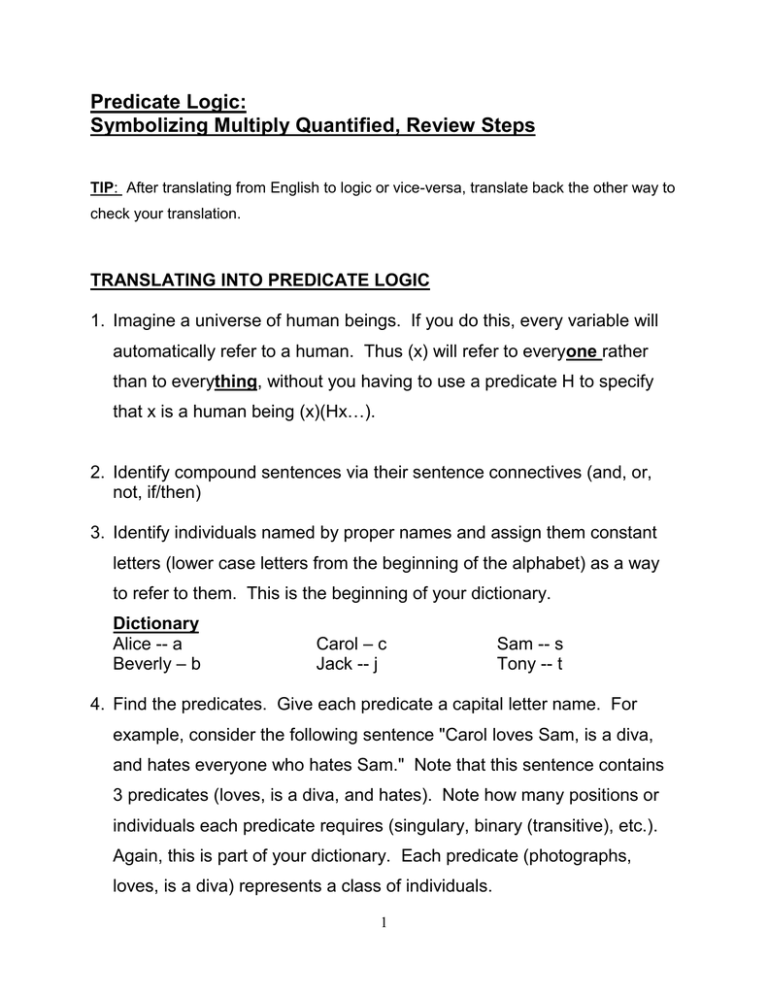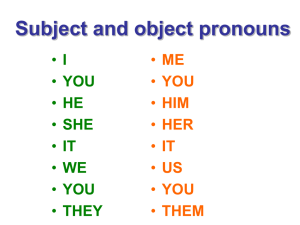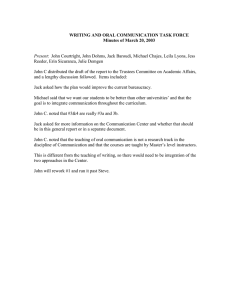Symbolize Predicate Logic Review Steps, Every type
advertisement

Predicate Logic: Symbolizing Multiply Quantified, Review Steps TIP: After translating from English to logic or vice-versa, translate back the other way to check your translation. TRANSLATING INTO PREDICATE LOGIC 1. Imagine a universe of human beings. If you do this, every variable will automatically refer to a human. Thus (x) will refer to everyone rather than to everything, without you having to use a predicate H to specify that x is a human being (x)(Hx…). 2. Identify compound sentences via their sentence connectives (and, or, not, if/then) 3. Identify individuals named by proper names and assign them constant letters (lower case letters from the beginning of the alphabet) as a way to refer to them. This is the beginning of your dictionary. Dictionary Alice -- a Beverly – b Carol – c Jack -- j Sam -- s Tony -- t 4. Find the predicates. Give each predicate a capital letter name. For example, consider the following sentence "Carol loves Sam, is a diva, and hates everyone who hates Sam." Note that this sentence contains 3 predicates (loves, is a diva, and hates). Note how many positions or individuals each predicate requires (singulary, binary (transitive), etc.). Again, this is part of your dictionary. Each predicate (photographs, loves, is a diva) represents a class of individuals. 1 Dictionary Pxy – x photographs y Dx – x is a diva Hxy – x hates y Cx – x is a child Usually we have to refer to members of any given class using quantifiers (to say how many individuals in the class, at least one, or all) and variables (to represent those individuals). Some people Descriptions of at least one (x) Every person Descriptions of whole classes (x) Any diva Descriptions of whole classes (x) No swimmer Descriptions of whole classes (x) ~(x) 5. Pick an appropriate quantifier ( or (x)) for each variable being assigned to a certain group, along with a variable letter. If the sentence contains two referrals to classes or parts of classes (everyone hates someone), you need two variables (x and y). In other words, you need a variable and a quantifier [(x) or (x)] for every "general reference" to a class or part of a class. The sentence “Everyone loves someone.” requires two different variables and two quantifiers. 1. Jack photographs Linda. 2. Linda likes Jack and Jack likes Linda. 3. Everyone hates Jack. 4. Not everyone hates Jack. 2 5. Carol is a diva. 6. Some people are divas but Alice is not. 7. All children swim. (Cx, is a child, Sx swim) 8. Some children swim but Alice does not. 9. Some children are not photographed by Jack. 10. Everyone hates someone. 11. Everyone is hated by someone. 12. There is someone who hates everyone. 13. There is someone who photographs someone. 14. Some children are not photographed by anyone. 15. Some photographers like everyone they photograph. 16. Some people like everyone who photographs them. 17. Some people hate everyone who photographs them and Beverly is one of them. 3



